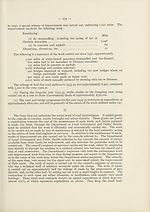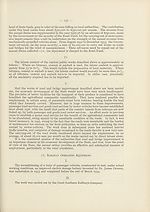Download files
Complete book:
Individual page:
Thumbnail gallery: Grid view | List view

— 136 —
holders occupied at a period of the year when agricultural work is not possible or necessary.
Such contracts are, however, confined to the rural areas of the counties, and are only made,
generally, in respect of roads of minor importance. The total amount expended by the
councils in the same areas by direct employment of men is about £1,250,000 per annum.
The legal provisions relating to roads and bridges are to be found scattered in many
enactments. The main enactments dealing with the subject are the bocal Government
Act, 1925, the Roads Act, 1920, and the Development and Road Improvement Funds
Act, 1909.
III.
The principal methods employed for financing road and bridge work are as follows :
(a) The local authorities—i.e., the councils of the several counties, county
boroughs and urban districts—estimate annually the cost of keeping the roads in
their areas in proper repair, and then raise the amount required by levying a rate on
the occupiers of lands and buildings on the basis of valuation of the premises. For
works of improvement, a similar course is followed, but, if the cost of carrying out a
particular type of improvement is large and the work of improvement likely to last
for many years, the council borrows from its treasurer the amount required. Such
borrowing cannot be made except with the consent of the Minister for Focal
Government and Public Health.
(b) Under the Finance Act, 1920, and subsequent Finance Acts, and the Roads
Act, 1920, the owners of mechanically-propelled vehicles pay an annual duty for
the use of the public roads. The amount is collected, in the first instance, by the
council of each county and county borough, and lodged to the credit of the State
in a Government account, known as the Road Fund. Apart from certain adminis¬
trative charges incidental to the collection of the duty, the Government does not use
any portion of the receipts from the annual duty on mechanically-propelled vehicles
for general revenue purposes. By virtue of the Roads Act, 1920, no portion of the
receipts can be expended otherwise than on the maintenance and improvement of
roads and bridges.
The following statement sets out the expenditure each year, from State and local
funds, respectively, on the maintenance and improvement of roads and bridges for the
financial years 1929-30 to 1933-34 inclusive :
Roads.
Amount allotted for year ended March 31st: ,
State funds Bocal funds
£ £
1929- 30 664,188 1,319,207
1930- 31 683,543 1,343,224
937.947 1.388,953
1932- 33 1,697,502 1,367,291
1933- 34 748,641 1,313,518 (approximately)
In addition to the foregoing, local authorities raised, during the period 1929-1934,
loans amounting to £278,561 for road and bridge work. They also raised loans within
the same period, amounting to £7,604, for the purchase of road plant.
As indicated in Section II above, the annual outlay by the councils on maintenance
work is about £1,500,000. A portion of the amounts in the foregoing total, listed under the
holders occupied at a period of the year when agricultural work is not possible or necessary.
Such contracts are, however, confined to the rural areas of the counties, and are only made,
generally, in respect of roads of minor importance. The total amount expended by the
councils in the same areas by direct employment of men is about £1,250,000 per annum.
The legal provisions relating to roads and bridges are to be found scattered in many
enactments. The main enactments dealing with the subject are the bocal Government
Act, 1925, the Roads Act, 1920, and the Development and Road Improvement Funds
Act, 1909.
III.
The principal methods employed for financing road and bridge work are as follows :
(a) The local authorities—i.e., the councils of the several counties, county
boroughs and urban districts—estimate annually the cost of keeping the roads in
their areas in proper repair, and then raise the amount required by levying a rate on
the occupiers of lands and buildings on the basis of valuation of the premises. For
works of improvement, a similar course is followed, but, if the cost of carrying out a
particular type of improvement is large and the work of improvement likely to last
for many years, the council borrows from its treasurer the amount required. Such
borrowing cannot be made except with the consent of the Minister for Focal
Government and Public Health.
(b) Under the Finance Act, 1920, and subsequent Finance Acts, and the Roads
Act, 1920, the owners of mechanically-propelled vehicles pay an annual duty for
the use of the public roads. The amount is collected, in the first instance, by the
council of each county and county borough, and lodged to the credit of the State
in a Government account, known as the Road Fund. Apart from certain adminis¬
trative charges incidental to the collection of the duty, the Government does not use
any portion of the receipts from the annual duty on mechanically-propelled vehicles
for general revenue purposes. By virtue of the Roads Act, 1920, no portion of the
receipts can be expended otherwise than on the maintenance and improvement of
roads and bridges.
The following statement sets out the expenditure each year, from State and local
funds, respectively, on the maintenance and improvement of roads and bridges for the
financial years 1929-30 to 1933-34 inclusive :
Roads.
Amount allotted for year ended March 31st: ,
State funds Bocal funds
£ £
1929- 30 664,188 1,319,207
1930- 31 683,543 1,343,224
937.947 1.388,953
1932- 33 1,697,502 1,367,291
1933- 34 748,641 1,313,518 (approximately)
In addition to the foregoing, local authorities raised, during the period 1929-1934,
loans amounting to £278,561 for road and bridge work. They also raised loans within
the same period, amounting to £7,604, for the purchase of road plant.
As indicated in Section II above, the annual outlay by the councils on maintenance
work is about £1,500,000. A portion of the amounts in the foregoing total, listed under the
Set display mode to:
![]() Universal Viewer |
Universal Viewer | ![]() Mirador |
Large image | Transcription
Mirador |
Large image | Transcription
Images and transcriptions on this page, including medium image downloads, may be used under the Creative Commons Attribution 4.0 International Licence unless otherwise stated. ![]()
| League of Nations > Communications and transit > Enquiry on national public works > (138) |
|---|
| Permanent URL | https://digital.nls.uk/195000144 |
|---|
| Shelfmark | LN.VIII |
|---|
| Description | Over 1,200 documents from the non-political organs of the League of Nations that dealt with health, disarmament, economic and financial matters for the duration of the League (1919-1945). Also online are statistical bulletins, essential facts, and an overview of the League by the first Secretary General, Sir Eric Drummond. These items are part of the Official Publications collection at the National Library of Scotland. |
|---|---|
| Additional NLS resources: |
|

